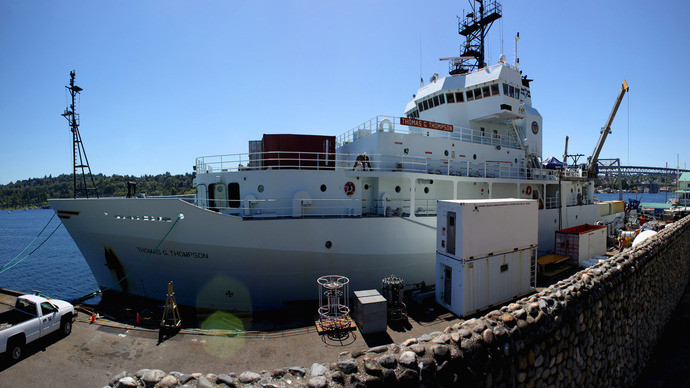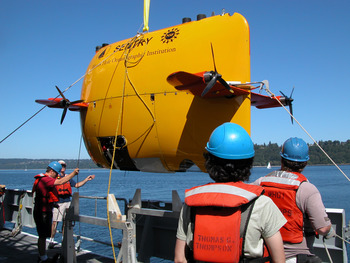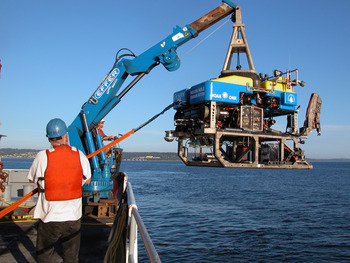By John R. Delaney, Chief Scientist, ENLIGHTEN '10
 |
| John Delaney |
A powerful and contagious sense of excitement pervades the entire crew on this particular seagoing expedition aboard the UW Research Vessel Thomas G. Thompson. We have set out for the Pacific Ocean on the first of many cruises related to implementation and eventual operation of a huge cabled submarine laboratory designed to conduct cutting-edge research in many portions of the ocean over the coming decades.
We left sun-drenched Seattle last evening prepared for an intense month-long effort off the coasts of Washington and Oregon. This cruise is part of the earliest stage of construction of the Regional Scale Nodes (RSN) component of the National Science Foundation's (NSF) Ocean Observatories Initiative (OOI). The RSN's novel cabled submarine network will provide vastly enhanced capabilities for in situ use of nearly unlimited electrical power and extraordinarily high-speed Internet communications. Hundreds, soon thousands, of instruments, sensors, and robots will be deployed at sea and controlled from shore by scientists and educators intent on being "present" throughout the full volume of the ocean.
As a full-scale prototype of a “Cabled Ocean Observatory," the RSN will allow continuous and nearly instantaneous transfer of information, imagery, and robotic control between undersea systems and land-based users. Researchers ranging from seismologists to meteorologists to marine mammal experts will interactively explore the oceans in the time domain as “the sea around us” changes, driven partly by shifts in climate and partly by shifts in massive tectonic plates. All facets of this activity will be accessible to anyone interested in participating via the Internet.
Such bold technological innovation will result in a rapid expansion of the productivity and creativity of a host of ocean scientists and educators striving to understand and communicate the immense complexity and power of the global ocean system. Covering two-thirds of Earth's surface, this massive, water-dominated portion of our home planet functions as the crucial, globally distributed, life-support system. So effective is this system that most people remain unaware of its profound influence on their daily lives.
Onboard the Thompson are some of the most powerful conventional tools available to conduct science in the ocean basins. Working with colleagues from the National Deep Submergence Group at Woods Hole Oceanographic Institution, we will simultaneously be deploying the Remotely Operated Vehicle Jason while deploying the new Autonomous Underwater Vehicle Sentry. Currently cutting edge themselves, these modern robotic platforms--AUV's and ROV's--are crucially important tools as we prepare to launch a remarkable and transformative expansion of humanity’s ability to work in, and be present throughout, the ocean -- a fiber-optically cabled undersea network wired to the Internet. We anticipate that these early steps will help usher into existence an entirely new era of inquiry and discovery focused on capturing and quantifying the myriad, complex phenomena operating within the ocean basins.
For more that 15 years, hundreds of scientists, students, educators, and engineers have worked together to launch this new approach. The result will enable a continuous human telepresence throughout an entire volume of the ocean, from the deep, dynamic, and virtually inaccessible world below the seafloor to the turbulent, but crucial, interface between the ocean and the atmosphere.
ENLIGHTEN '10, to be documented in these webpages as it unfolds for the coming month, may well become an early microcosmic version of the final product – the cabled ocean observatory. That is, by streaming video from the ship and the seafloor in real time we can invite you and your friends and colleagues to join us from your homes, offices, laboratories, and classrooms as we push on the boundaries of what we can do in the open ocean. Please join us when possible.
The OOI is funded by the National Science Foundation. It is managed and coordinated by the Consortium for Ocean Leadership. The University of Washington is taking the leading role in this cruise as the implementing organization for the RSN component of the OOI. Partner institutions on the cruise include Oregon State University, a member of the implementing organization for the OOI Coastal and Global Scale Nodes, and Arizona State University.



